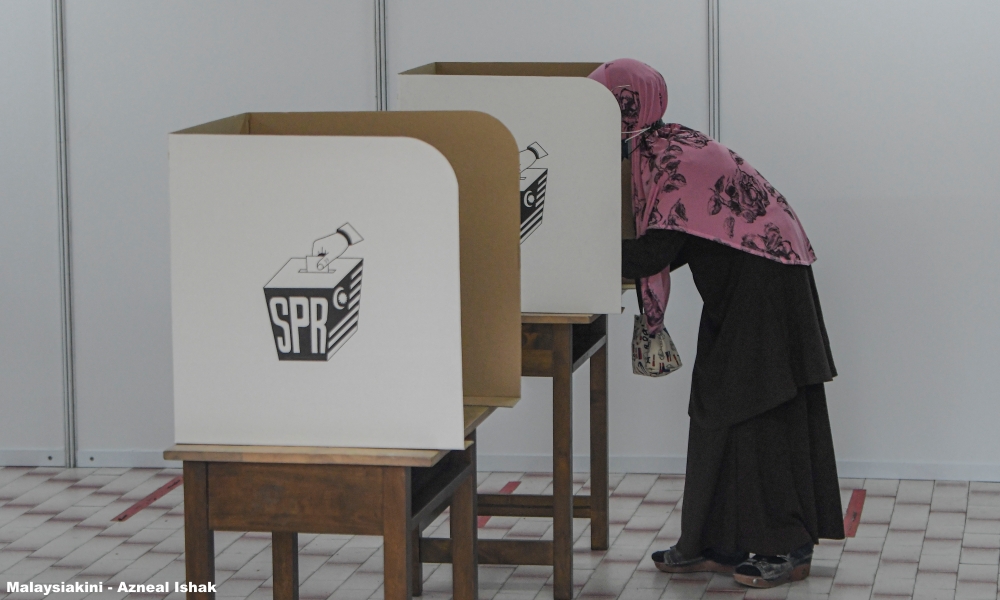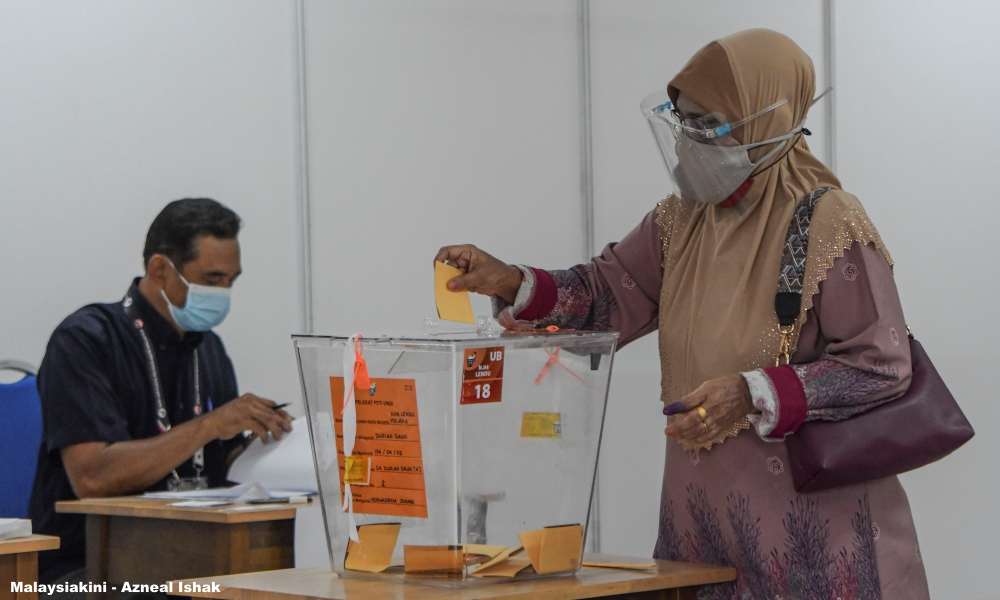Yesterday, we assessed how malapportionment divides Malaysian society due to certain demographic backgrounds and particular patterns associated with constituencies with different electorate sizes. This article focuses on a step-by-step process to rectify issues with our unfairly drawn constituencies.
First step: Fixing polling district mess
The 13th Schedule of the Constitution lays the guidelines on how constituencies are drawn. One of the key rules for drawing electoral boundaries is the constituencies have to be drawn with consideration of facilities that can assist with voter registration and polling machinery. With the implementation of Undi18 and automatic voter registration, the process itself exposed a hidden problem in redelineation – insufficient polling centres.
Every voter is assigned to a polling district (the building block of constituencies) where the polling district is assigned to a polling centre.
While one can assume the said polling district would have an in-house polling centre, the reality is many polling districts are drawn with little consideration of polling centre availability. For example, around 13 percent of the electors of Penang have been asked to vote outside their home state constituency as the Election Commission (EC) has drawn constituencies with insufficient polling centres.
After GE14, four states (Penang, Selangor, Johor, and Terengganu) have been contemplating triggering redelineation by changing the number of state constituencies (DUN). Unfortunately, these state governments did not highlight the issue of poor allocation of polling centres by the EC.
All state governments must lobby EC to ensure every polling district is drawn with these five principles:
Polling districts to respect mukim and local council boundaries and local ties.
Polling districts to have an electorate size of two percent to four percent of the parliamentary electoral quota of the state (average parliamentary electorate size).
Polling districts to have names representative of the area.
Polling districts to have two in-house facilities for polling centres.
Correct association of voters to polling districts.
The first step for a fair redelineation journey requires no constitutional amendment as it is under EC’s domain. The commission must be pressured to fix the polling district mess first. If a state pursues DUN size increase without this first step, more inaccessible constituencies for voters will be created.

Second step: Getting constituency count right
The second step for fair redelineation, especially for states which want to fix their constituencies, is getting the constituency count right.
I lay one major question to the readers – is the current Dewan Rakyat size ideal for our Malaysian population size? If we use the well-known cube root rule (taking the cube root of the 2021 population), the number of MPs will increase from 222 to 319.
If we use the Wyoming rule (for our case, dividing the population of Malaysia by the population of Perlis or Labuan), we would have either 128 MPs (if we use Perlis) or 327 MPs (if we use Labuan).
Currently, it is not possible for politicians to accept a decrease in the Dewan Rakyat size, nor are they focusing on increasing the Dewan Rakyat size.
For the states who are contemplating triggering redelineation through DUN size increase, these states should consider applying the principle of multiple for its DUN size. The principle of multiple states that the total constituencies of DUN shall be the same or multiple of parliamentary constituencies of a given state.
First implied in the 1957 constitution, codified in 1962 and repealed in 1983, the principle of multiple is the first step for concurrent equalisation for state and parliamentary constituencies.
In Malaysian history, the full potential of this principle was realised once – during the 1960 redelineation, the last fair redelineation in Malaysia.
For example, Selangor has 22 parliamentary and 56 constituencies currently. Hence, even if EC did fair redelineation where all state constituencies were within +/-15 percent of the state DUN quota (average state constituency size), it will not be possible for EC to do the same at the parliamentary level.
In the previous article, I have shown a table of the disparity between the largest and smallest parliamentary constituencies for every state. Even with the implementation of Undi18, the three states which retain the principle of multiple – Pahang, Perlis, and Terengganu – have the lowest disparities in the country.
READ MORE: COMMENT | How malapportionment devalues your vote
Perlis is the only state where all parliamentary constituencies are equal. Terengganu has no reason for a DUN increase as it has respected the principle of multiple. Some argued that DUN size should be an odd number for governance reasons.
However, a state should only consider an odd number for DUN size if the principle of multiple is adhered to (for example, Penang can have an odd number of DUN (39) as it would be a multiple of 13 parliamentary seats in Penang).
As this step requires a constitutional amendment, the ideal constituency count should be deliberated carefully together with consideration of a state’s financial capacity.

Third step: Defined limits for constituency size
The third step for fair redelineation is defining clear upper and lower limits for the constituency's electorate size. Ideally, we should aspire for the allocation power of parliamentary constituencies to be taken away from Dewan Rakyat and hand it to the future Boundaries Commission (a new body). This will allow full rectification of interstate malapportionment (where currently, Selangor’s voting value is less than Pahang’s voting value).
The future Boundaries Commission should allocate parliamentary constituencies to each state due to population/electorate size without causing undue disparity among states. Within a state, all DUN and parliamentary constituencies should be drawn within +/-15 percent of the state parliamentary/DUN quota for Peninsular Malaysian states.
With Kelantan being the last state to join the urbanisation club in 2019, particularly for Peninsular Malaysia, the majority of the constituencies are accessible through road and telecommunication networks. Together with the principle of multiple, this will equalise all constituencies. For Sabah and Sarawak, we will use the limits of +/-25 percent of the state parliamentary/DUN quota.
For states that intend to trigger redelineation, they must lobby the EC to ensure constituencies are within the electorate size limits mentioned before. Some argue that it is possible to codify such hard limits on constituency size within state constitutions. Legal advisers must be consulted on whether such a possibility does not collide with the Federal List as elections (including redelineation) fall under federal responsibility.
As this step requires a constitutional amendment, defining appropriate limits (i.e., +/-15 percent) is a crucial step in enforcing equalisation for all Malaysians (in an electoral sense).
Fourth step: Respecting local ties
With equalisation in mind, all constituencies are drawn with proper respect to local boundaries or local ties such as administrative districts, local council boundaries and development blocks. Adherence to local boundaries must be done in view of two major considerations.
Ability to draw constituencies that respect the principle of equality.
Ability to draw constituencies with a regular shape.
In Malaysia, there are local councils and district areas that have exclaves (e.g., Muallim in Perak and Padawan Municipal Council in Sarawak). In this instance, constituencies drawn should not follow such boundaries completely as such districts or council areas have disrespected local ties.
Secondly, we must understand administrative and local council areas are drawn with different intentions and not with equalisation in mind. If a local council area (with ‘x’ number of electors) can fit 3.5 parliamentary constituencies, the EC should be given the space to draw a parliamentary constituency to straddle over two local councils.

Equalisation must take precedence. To minimise such occurrence, the state government and EC should discuss fixing the polling district shape as soon as possible before a redelineation takes place. The state government should remove any inconsistencies between local council and administrative boundaries (e.g., Selangor) so that confusion does not arise during the redelineation process.
Moreover, DUN constituencies should be parked under one council or district area as much as possible. We must acknowledge that the design of the constituency can influence who becomes the returning officer (RO) for a given election.
In 2018, the RO for DUN Rantau was the district officer for Rembau, and he blocked the entry of PKR’s Dr S Streram on frivolous grounds (causing an uncontested victory). The bigger issue is that DUN Rantau received a RO from a different district.
Rantau is geographically located in Seremban district yet electorally associated with the Rembau parliamentary constituency. The Rembau constituency was drawn in a way that violated local ties as the DUN constituency of Rantau has minimal local ties with the Rembau district. In 2019, the EC appointed the right RO - Seremban’s district officer - for the DUN Rantau by-election.
In short, state governments and the EC should ensure constituencies are drawn in a manner that respects local ties, and this ensures the right electoral administrators run the elections of a given area.
Conclusion
It is important that the groundwork for fair boundaries can be laid without requiring constitutional amendments right away. At this point, every state government should discuss with the EC to fix polling districts. Subsequently, for the states which want to trigger redelineation, determining the right constituency count is of paramount importance.
Finally, governments (either state or federal or both) should look for a way to ensure necessary constitutional amendments are made to eliminate gerrymandering and malapportionment. By understanding the sequence for fair redelineation, fair treatment for all Malaysians would be made possible.- Mkini
DANESH PRAKASH CHACKO is a research analyst at Jeffrey Sachs Center on Sustainable Development (Sunway University). He also serves as the director of Tindak Malaysia, an electoral reform advocacy group.
The views expressed here are those of the author/contributor and do not necessarily represent the views of MMKtT.




No comments:
Post a Comment
Note: Only a member of this blog may post a comment.